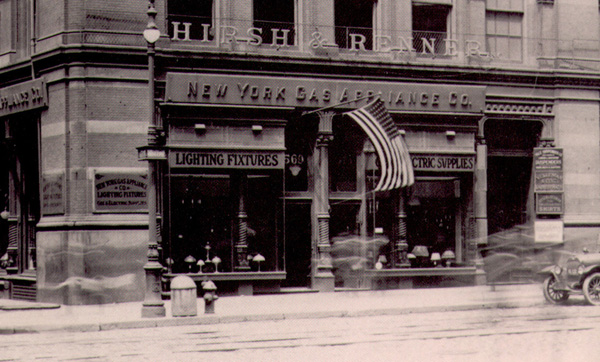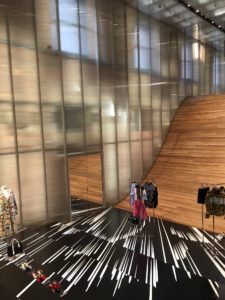The Prada Store, located at 575 Broadway at the corner of Prince Street, made a huge splash in the New York fashion and architecture worlds when it first opened in 2001.
Prada, the luxury fashion brand, was founded in 1913 by Mario Prada as “Fratelli Prada” (Parade Brothers), makers of luggage and steamer trunks for a then burgeoning travel market. After Mario Prada’s death in 1952, the company went into decline until Mario’s granddaughter, Miuccia, took over the company in 1978.
Miuccia Prada has been credited with Prada’s meteoric rise in the fashion world. An aspiring politician with a PhD in Political Science, Miuccia, together with her husband Patrizio Bertelli, has run the company for the last 40 years and also founded Fondazione Prada, an institution dedicated to contemporary art and culture
The Prada building at 575 Broadway, also called the Rogers, Peet, and Co. Building, was built in 1882 by John Jacob Astor and designed by architect Thomas Stent in the “commercial palace” style, its first ground floor tenant was Rogers, Peet & Co., a men’s and boy’s clothing store. The upper floors were occupied mostly by hat dealers, including Frank F. Hodges & Co., Thomas H. Wood & Co., and Hirsch & Park, makers of straw hats for ladies, misses and children. (source)

The New York Gas Appliance Co. on Broadway ca. 1920s
The Astors sold the building in the 1920’s. Rogers Peet moved out as the garment industry moved further north up Broadway and The New York Gas Appliance Company, dealers of light fixtures, moved in. As electricity became more commonplace and the company grew, they adopted the name Lightolier, a combination of the words “light” and “chandelier, and began producing high end lighting fixtures and is today a part of the Philips Lighting.
Just over a hundred years after its opening, 575 Broadway was redesigned by architect Arata Isozaki to become the home of the Guggenheim Museum SoHo in 1991. During its decade on Broadway, the Guggenheim SoHo exhibited the work of major artists including Marc Chagall, Paul Klee, Robert Rauschenberg, and Andy Warhol.
Prada opened in its current space in 2001, taking over the first floor of the building while the Guggenheim remained open for another year on the upper floors until it closed permanently in 2002. Redesigned once again, this time by superstar architect Rem Koolhaas, Prada SoHo is called an “epicenter,” which implies that it is more than merely a flagship. The ground floor showcases very little clothing and a lot of design, including a glass-shaft cylindrical elevator and what Koolhaas calls the “wave,” a wooden floor that undulates, dipping down to the store’s lower level and rising up again in a series of steps which do double duty as display platforms and seating for visitors.
 In 2001, just after the store’s opening, Koolhaas told The Washington Post, “We were worried about the incredible commercial development of SoHo. …There was almost no public space left. This space can be in its entirety commercial. This entire space can also be a space for New York.” In a neighborhood with little public space, this is a wonderful notion. At present, the space is not used for public events, but during store hours, it is, of course, open to the public.
In 2001, just after the store’s opening, Koolhaas told The Washington Post, “We were worried about the incredible commercial development of SoHo. …There was almost no public space left. This space can be in its entirety commercial. This entire space can also be a space for New York.” In a neighborhood with little public space, this is a wonderful notion. At present, the space is not used for public events, but during store hours, it is, of course, open to the public.
And while you’re there, look for Prada’s “new” black nylon bag. By resurrecting the material that made Prada handbags famous in the 1980s, the company looks back to a past golden age and brings it into the future, for its fall 2018 mens collection that includes a backwards backpack designed by none other than Rem Koolhaas.
Read more from the Look Back at SoHo Broadway Series by Yukie Ohta